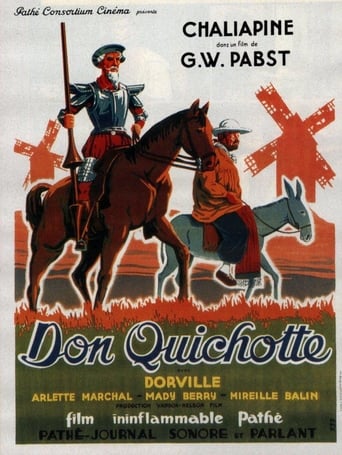loza-1
It is unusual to see scrappy direction from Pabst, but I was disappointed with this film. What is interesting about this film is Shalyapin.In opera, and folksong, Shalyapin took the art of acting seriously. He would jump into the skin of the character he was playing or of the narrator of a song. He was almost like Lon Chaney, when it came to costume.Here the great man sings in English, and seems to be ideal as the pathetic character who sells all he has, to buy books of knightly romances; then, with his servant, Sancho Panza, sets out to do good deeds.Shalyapin's English is excellent, and he speaks and sings with a heavy accent that is Russian, tinged with the accent of the country in which he lived in exile - France.George Robey, with his music hall accent, who was beginning to shake off his "coward" image (He was a conscientious objector during the first world war) plays Sancho Panza. Shalyapin does sing some songs in this scrappy production; but, unlike, Pabst, he does not leave us disappointed.
Armand
For me, this film is defined by the printed paper and his metamorphosis. The bustle, the delicate ash, the music are principal words of Cervantes masterpiece definition. So, the film must be a success at least for impressive presence of Chaliapin.In fact, it is not a film but a huge monument, the Baroque interpretation of Chaliapin has the talent to create a fantastic world.The pathetism of opera is part of gorgeous sophisticated fine expressionOnly values for a verdict in this case are subjectives. A legend of Russian Opera is Don Quixote. Every feature of character is slice of a subtle science of chimera's revelation. Every gesture is a form to describe sweet secret of fragile world. And Chaliapin is Chaliapin.But, more important, it is statute of testimony. The trip between symbols and facts, between refuges and truth. "Don Quixote" is not a ordinary picturization, it is a propaganda instrument.The three versions, "Man and Mask", the recordings , Mefistofele, the shows in Europe and the fame are elements of a special artist portrait who gives to his character not only a special soul but a subtle vision about life and illusion.I believe that this movie was for Chaliapin an adventure. His art is same, his acting is interesting and correct. For he, the hero from La Mancha is an alter-ego not ordinary character. So, the force of interpretation is charming, strong and pure.
pompierson
Miguel de Cervantes's great novel, "Don Quixote," (Part One, 1605, Part Two, 1615)has been treated in opera, musical comedy, Spanish zarzuela, ballet, film and the fine arts, though it is best played out in the theater of the imagination. To this film can come closest and G. W. Pabst's sensitive treatment in black and white does well indeed. The great Russian bass Feodor Chaliapin, who sang the title role in Jules Massenet's gorgeous 1910 opera, "Don Quichotte," plays Don Quixote, and sings too, with nice music credited to Jacques Ibert. George Robey makes a splendid Sancho Panza. The adaptation is intelligent, with many of the best known episodes treated,if not in the same order as in the book. The film handles well the Duke and Duchess, who humor Don Quixote and Sancho Panza for their amusement, but are somewhat humbled. Having the windmills (Part One, chapter 8) and burning of romances of chivalry at the end (Part One, chapter 6), with the death of Quixote, works surprisingly well. It is worth cleaning up and re-releasing, if possible.
psteier
I saw the New York Museum of Modern Art's print (the English language version). Only Chaliapin does much singing, but the music and lyrics are not much and I suggest you listen to his recordings to judge his singing. His acting seems very much staged.George Robey is very good as Sancho Panza (Don Quixote's servant), playing him as a Music Hall character. The scene with the traveling players at an inn is also interesting and fun.
